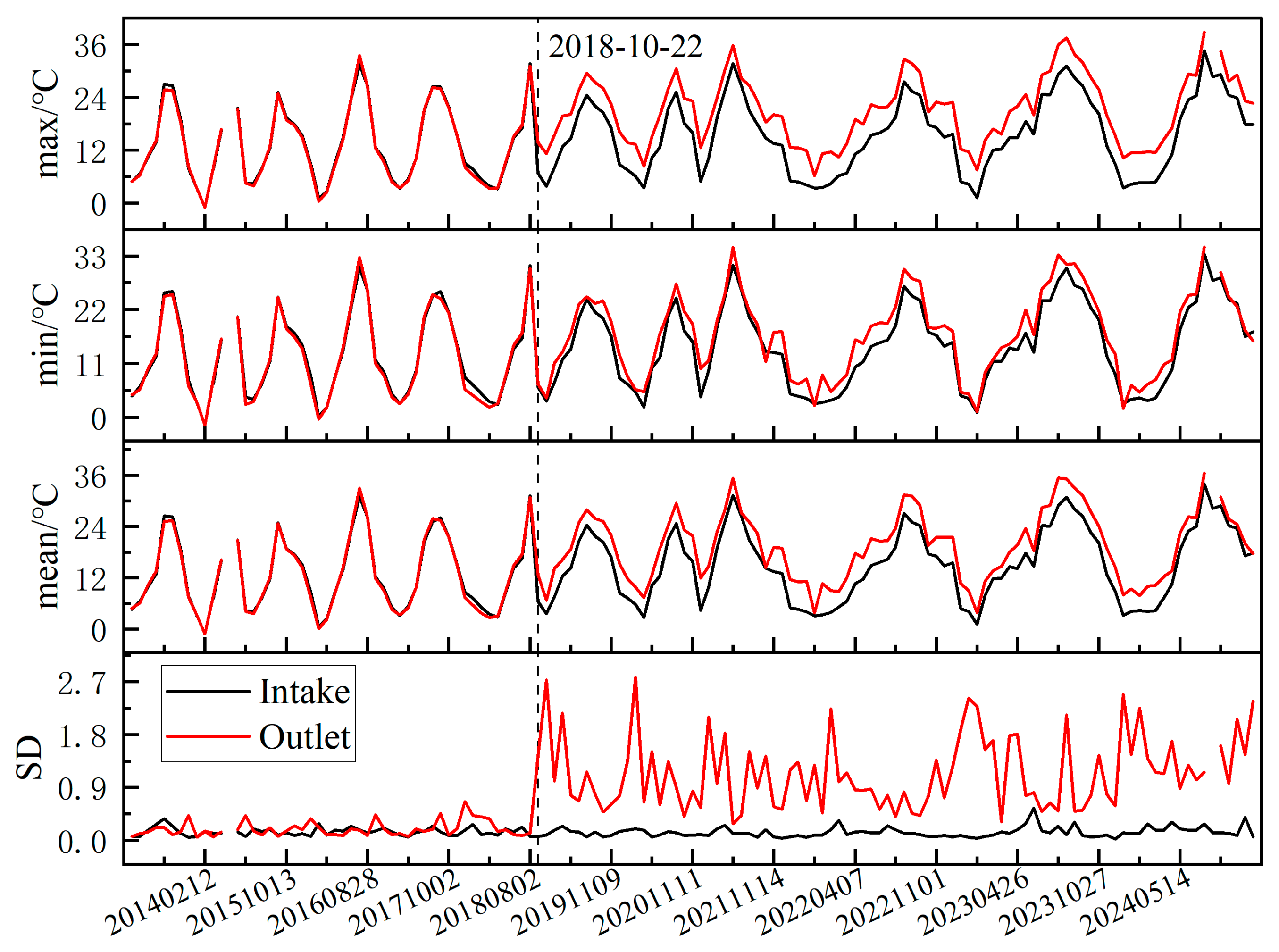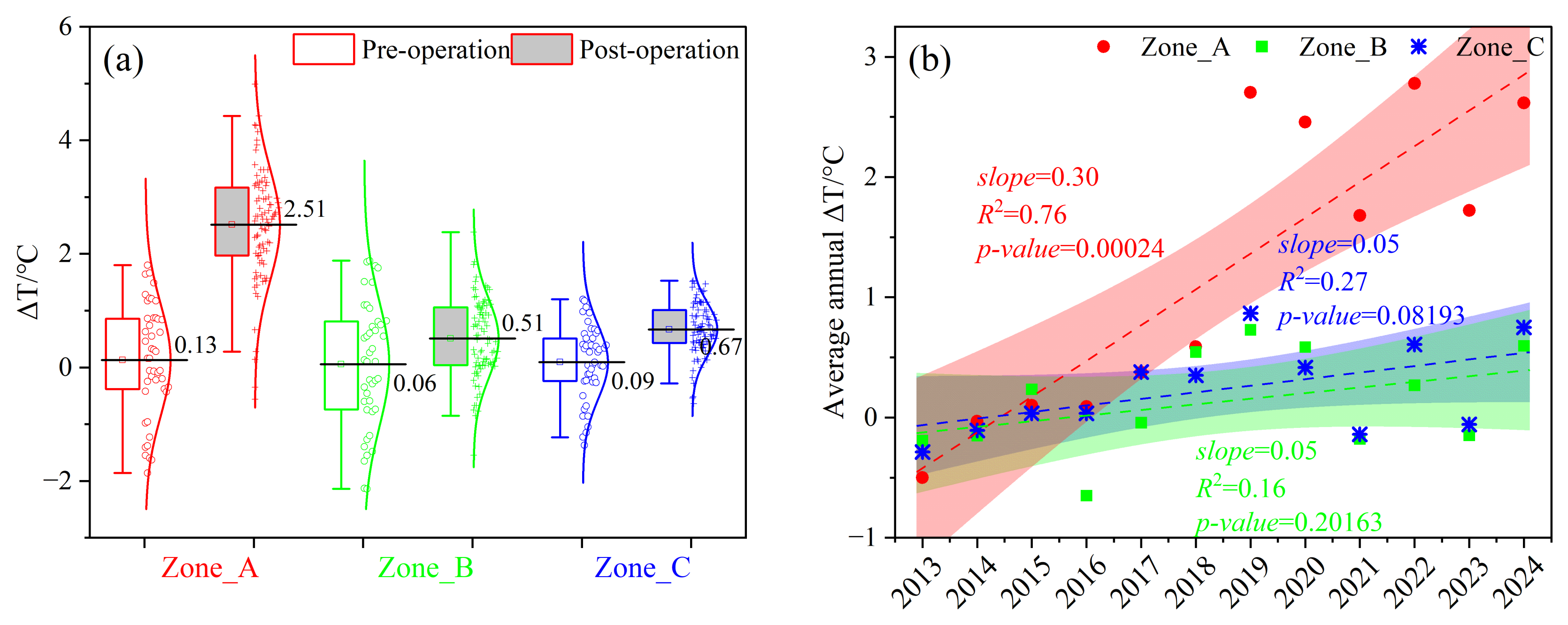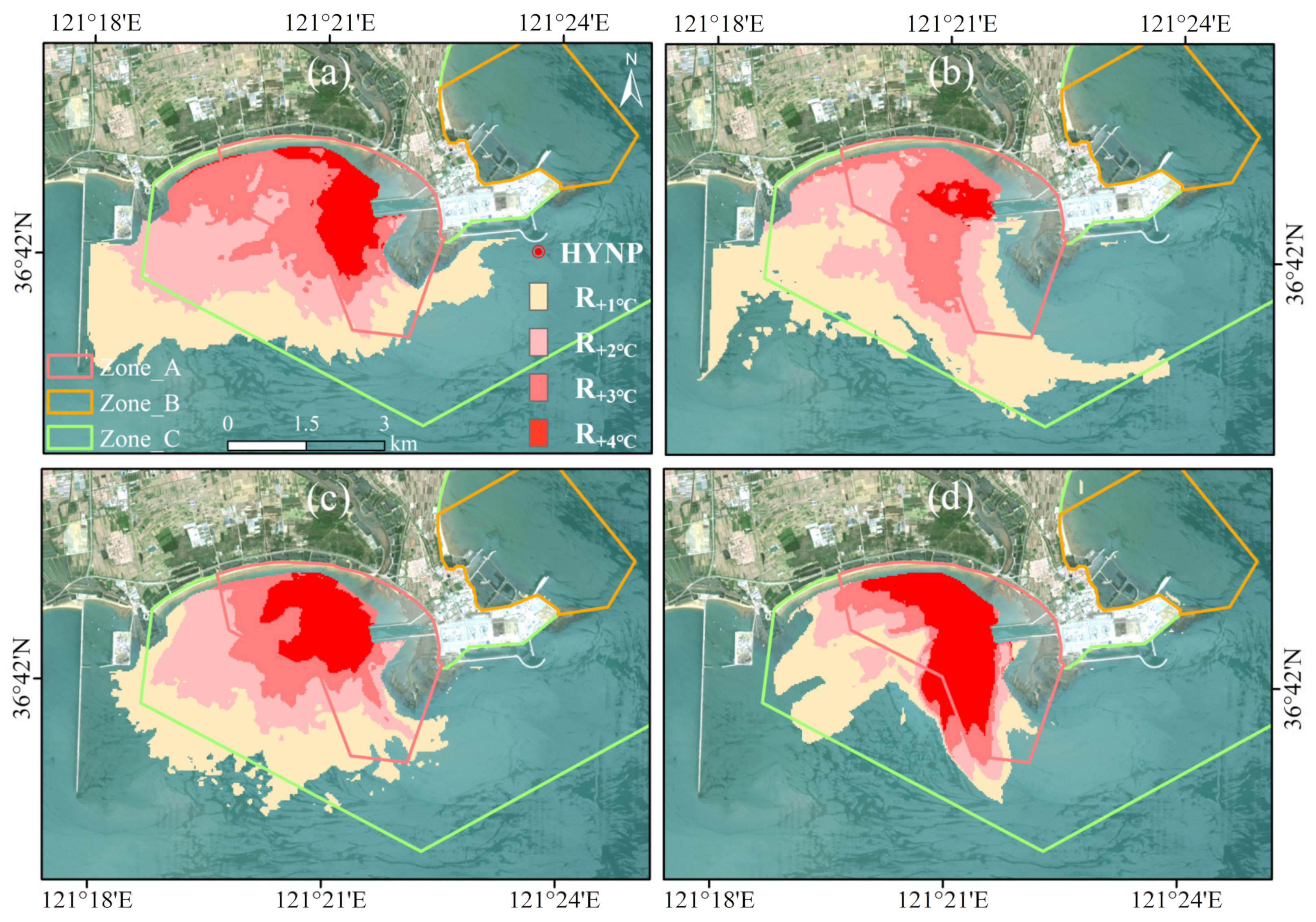Quantifying Thermal Discharges from Nuclear Power Plants: A Remote Sensing Analysis of Environmental Function Zones
Abstract
1. Introduction
2. Data and Methods
2.1. Study Area
2.2. Data and Preprocessing
- (1)
- Landsat Imagery
- (2)
- EFZs data
- (3)
- Tidal Data
- (4)
- Criterion for Temperature Rise Intensity Grading
3. Results
3.1. Thermal Impact of HYNPP Operation on Intake and Outlet Water
3.2. Spatial Patterns of Thermal Discharge in Response to Varying Tidal Conditions
4. Discussion
4.1. Impact of Thermal Discharge on SST in EFZs
4.2. Comparative Analysis of Thermal Discharge Diffusion Ranges in Different EFZs
- (1)
- Temperature rise of discharged water. Winter thermal discharge exhibits a higher temperature rise (10.79 °C) compared to summer (8.09 °C) due to HYNPP design. This elevated temperature rise in winter concentrates the high-temperature water near the discharge point, resulting in a significantly larger influence area with higher temperature rises.
- (2)
- Water body mixing. Winter’s stronger vertical mixing within the water body accelerates the dispersion and cooling of the thermal discharge, reducing its influence range. Conversely, summer’s pronounced thermal stratification inhibits mixing and cooling, resulting in a larger area of influence and a more persistent thermal plume [23].
5. Conclusions
Author Contributions
Funding
Institutional Review Board Statement
Informed Consent Statement
Data Availability Statement
Acknowledgments
Conflicts of Interest
References
- Zhang, A.; Wang, S.; Zhao, Y.; Yuan, J. Analysis of key issues in environmental impact assessment of thermal discharge from coastal nuclear power plant. Environ. Impact Assess. 2015, 37, 57–60. [Google Scholar]
- Available online: http://nnsa.mee.gov.cn/ztzl/jgdxsjk/hdc/yxhdjz/ (accessed on 5 November 2024).
- Lin, J.; Zou, X.; Huang, F.; Yao, Y. Quantitative estimation of sea surface temperature increases resulting from the thermal discharge of coastal power plants in China. Mar. Pollut. Bull. 2021, 164, 112020. [Google Scholar] [CrossRef] [PubMed]
- Karås, P. Zooplankton entrainment at Swedish nuclear power plants. Mar. Pollut. Bull. 1992, 24, 27–32. [Google Scholar] [CrossRef]
- Hung, T.-C.; Huang, C.-C.; Shao, K.-T. Ecological survey of coastal i water adjacent to nuclear power I plants in Taiwan. Chem. Ecol. 1998, 15, 129–142. [Google Scholar] [CrossRef]
- Poornima, E.; Rajadurai, M.; Rao, T.; Anupkumar, B.; Rajamohan, R.; Narasimhan, S.; Rao, V.; Venugopalan, V. Impact of thermal discharge from a tropical coastal power plant on phytoplankton. J. Therm. Biol. 2005, 30, 307–316. [Google Scholar] [CrossRef]
- de Oliveira Dias, C.; Bonecker, S.L.C. Long-term study of zooplankton in the estuarine system of Ribeira Bay, near a power plant (Rio de Janeiro, Brazil). Hydrobiologia 2008, 614, 65–81. [Google Scholar] [CrossRef]
- Teixeira, T.P.; Neves, L.M.; Araújo, F.G. Effects of a nuclear power plant thermal discharge on habitat complexity and fish community structure in Ilha Grande Bay, Brazil. Mar. Environ. Res. 2009, 68, 188–195. [Google Scholar] [CrossRef]
- Ingleton, T.; McMinn, A. Thermal plume effects: A multi-disciplinary approach for assessing effects of thermal pollution on estuaries using benthic diatoms and satellite imagery. Estuar. Coast. Shelf Sci. 2012, 99, 132–144. [Google Scholar] [CrossRef]
- Lee, P.-W.; Tseng, L.-C.; Hwang, J.-S. Comparison of mesozooplankton mortality impacted by the cooling systems of two nuclear power plants at the northern Taiwan coast, southern East China Sea. Mar. Pollut. Bull. 2018, 136, 114–124. [Google Scholar] [CrossRef]
- Wang, J.; Tao, Z.; Wang, Y.; Wei, H.; Liu, X.; Li, C. Effects of Liaoning Hongyanhe Nuclear Power Plant on the Zooplankton Community in Summer of 2017. J. Ocean. Univ. China 2020, 19, 1140–1152. [Google Scholar] [CrossRef]
- Wu, J.; Kong, J.; Laws, E.A.; Liu, X.; Wang, C.; Chen, J.; Chen, M.; Yao, Q.; Wang, Y.; Zhen, Y.; et al. The Link Between Marine Thermal Discharges and Nemopilema Nomurai Blooms Around Nuclear Power Plants. Ecosyst. Health Sustain. 2023, 9, 9. [Google Scholar] [CrossRef]
- Jia, H.; Shen, Y.; Su, M.; Yu, C. Numerical simulation of hydrodynamic and water quality effects of shoreline changes in Bohai Bay. Front. Earth Sci. 2018, 12, 625–639. [Google Scholar] [CrossRef]
- Zhang, L.; Shi, H.; Xing, H.; Li, P.; Ma, P. Analysis of the evolution of the Yellow River Delta coastline and the response of the tidal current field. Front. Mar. Sci. 2023, 10, 1232060. [Google Scholar] [CrossRef]
- Xing, X.; Zhang, Z.; Tang, J.; Guo, T.; Wang, S.; Tao, Z. Study on the Issue about Water Intake Blockage by Marine Organism in Nuclear Power Plant. Nucl. Saf. 2021, 20, 103. [Google Scholar]
- Chavan, P.; Kumar, R.; Kirubagaran, R.; Venugopalan, V.P. Comparative toxicological effects of two antifouling biocides on the marine diatom Chaetoceros lorenzianus: Damage and post-exposure recovery. Ecotoxicol. Environ. Saf. 2017, 144, 97–106. [Google Scholar] [CrossRef]
- Muthulakshmi, A.; Natesan, U.; Ferrer, V.A.; Deepthi, K.; Venugopalan, V.; Narasimhan, S. Impact assessment of nuclear power plant discharge on zooplankton abundance and distribution in coastal waters of Kalpakkam, India. Ecol. Process. 2019, 8, 22. [Google Scholar] [CrossRef]
- Zargar, S.; Ghosh, T. Thermal and biocidal (chlorine) effects on select freshwater plankton. Arch. Environ. Contam. Toxicol. 2007, 53, 191–197. [Google Scholar] [CrossRef]
- Torres, M.J.F.; Beviá, F.R. Chlorine use reduction in nuclear or conventional power plants: A combined cooling-and-stripping tower for coastal power plants. J. Clean. Prod. 2012, 26, 1–8. [Google Scholar] [CrossRef]
- Mallikarjuna, M.; Katiyar, V.; Basavarajappa, K.; Kumar, T. Mathematical study on thermal pollution with reference to diffusional transfer of dispersants. Arya Bhatta J. Math. Inform. 2022, 14, 1–6. [Google Scholar] [CrossRef]
- Zhu, L.; Zhao, L.; Wang, Q.; Zhang, A.; Wu, C.; Li, J.; Shi, J. Monitoring the thermal plume from coastal nuclear power plant using satellite remote sensing data: Modeling and validataion. Spectrosc. Spectr. Anal. 2014, 34, 3079–3084. [Google Scholar]
- Zheng, Z.; Zhang, J.; Gong, H. Uncertainty analysis of MIKE SHE hydrologic model parameter. Yellow River 2015, 37, 23–26. [Google Scholar]
- Tang, D.; Kester, D.R.; Wang, Z.; Lian, J.; Kawamura, H. AVHRR satellite remote sensing and shipboard measurements of the thermal plume from the Daya Bay, nuclear power station, China. Remote Sens. Environ. 2003, 84, 506–515. [Google Scholar] [CrossRef]
- Zhou, Y.; Gong, C.; Kuang, D.; Hu, Y. Distribution of thermal discharge from a power plant: Analysis of thermal infrared data from the environmental mitigation satellite. J. Infrared Millim. Waves 2012, 31, 544–549. [Google Scholar] [CrossRef]
- Ahn, Y.H.; Shanmugam, P.; Lee, J.H.; Kang, Y.Q. Application of satellite infrared data for mapping of thermal plume contamination in coastal ecosystem of Korea. Mar. Environ. Res. 2006, 61, 186–201. [Google Scholar] [CrossRef]
- Faulkner, A.; Bulgin, C.E.; Merchant, C.J. Coastal Tidal Effects on Industrial Thermal Plumes in Satellite Imagery. Remote Sens. 2019, 11, 2132. [Google Scholar] [CrossRef]
- Liu, M.; Yin, X.; Xu, Q.; Chen, Y.; Wang, B. Monitoring of Fine-Scale Warm Drain-Off Water from Nuclear Power Stations in the Daya Bay Based on Landsat 8 Data. Remote Sens. 2020, 12, 627. [Google Scholar] [CrossRef]
- Xing, M.; Wang, D.; He, X.; Bai, Y.; Cheng, Y. Temporal and spatial characteristics of thermal discharge in Tianwan Nuclear Power Plant based on remote sensing data. J. Mar. Sci. 2020, 38, 72. [Google Scholar]
- Lin, J.; Zou, X.; Huang, F. Quantitative analysis of the factors influencing the dispersion of thermal pollution caused by coastal power plants. Water Res. 2021, 188, 116558. [Google Scholar] [CrossRef]
- Zhang, Z.; Wang, D.; Cheng, Y.; Gong, F. Long-Term Changes and Factors That Influence Changes in Thermal Discharge from Nuclear Power Plants in Daya Bay, China. Remote Sens. 2022, 14, 763. [Google Scholar] [CrossRef]
- Wang, X.; Su, X.; Wang, L.; Xinxin, W.; Chen, Y. Unmanned remote sensing identification and driving force analysis of spatial distribution of thermal discharge from coastal nuclear power plant. Mar. Environ. Sci. 2023, 42, 542–549. [Google Scholar] [CrossRef]
- GB3097-1997; National Seawater Quality Standard of the People’s Republic of China. National Environmental Protection Administration: Beijing, China, 1997.
- Cook, M.; Schott, J.R.; Mandel, J.; Raqueno, N. Development of an operational calibration methodology for the Landsat thermal data archive and initial testing of the atmospheric compensation component of a Land Surface Temperature (LST) Product from the archive. Remote Sens. 2014, 6, 11244–11266. [Google Scholar] [CrossRef]
- Wei, J.; Feng, L.; Tong, Y.; Xu, Y.; Shi, K. Long-term observation of global nuclear power plants thermal plumes using Landsat images and deep learning. Remote Sens. Environ. 2023, 295, 113707. [Google Scholar] [CrossRef]







| Power Unit | Reactor Type | Gross Capacity | First Criticality Date | Commercial Operation Date |
|---|---|---|---|---|
| No. 1 | PWR | 1253 MW | 8 August 2018 | 22 October 2018 |
| No. 2 | PWR | 1253 MW | 29 September 2018 | 9 January 2019 |
| Ranges of SST Increases | Levels |
|---|---|
| [+1 °C, +2 °C) | R+1 |
| [+2 °C, +3 °C) | R+2 |
| [+3 °C, +4 °C) | R+3 |
| ≥4 °C | R+4 |
| Area | Operation Status | SST Parameters | |||
|---|---|---|---|---|---|
| Max/°C | Min/°C | Mean/°C | SD | ||
| Intake | Pre-operation | 31.67 | 0.15 | 13.08 | 0.15 |
| Post-operation | 31.66 | 0.98 | 13.38 | 0.12 | |
| Outlet | Pre-operation | 33.49 | −0.33 | 12.95 | 0.20 |
| Pre-operation | 31.67 | 0.15 | 13.08 | 0.15 | |
| Season | Area/km2 | ||||
|---|---|---|---|---|---|
| R+1 | R+2 | R+3 | R+4 | Atotal | |
| Spring | 9.6 | 5.0 | 5.8 | 3.5 | 23.9 |
| Summer | 15.8 | 6.7 | 6.8 | 4.1 | 33.4 |
| Autumn | 10.1 | 4.7 | 3.9 | 5.4 | 24.1 |
| Winter | 2.8 | 3.2 | 7.6 | 5.7 | 19.3 |
Disclaimer/Publisher’s Note: The statements, opinions and data contained in all publications are solely those of the individual author(s) and contributor(s) and not of MDPI and/or the editor(s). MDPI and/or the editor(s) disclaim responsibility for any injury to people or property resulting from any ideas, methods, instructions or products referred to in the content. |
© 2025 by the authors. Licensee MDPI, Basel, Switzerland. This article is an open access article distributed under the terms and conditions of the Creative Commons Attribution (CC BY) license (https://creativecommons.org/licenses/by/4.0/).
Share and Cite
Wang, X.; Su, X.; Wang, L.; Wang, X.; Meng, Q.; Xu, J. Quantifying Thermal Discharges from Nuclear Power Plants: A Remote Sensing Analysis of Environmental Function Zones. Appl. Sci. 2025, 15, 738. https://doi.org/10.3390/app15020738
Wang X, Su X, Wang L, Wang X, Meng Q, Xu J. Quantifying Thermal Discharges from Nuclear Power Plants: A Remote Sensing Analysis of Environmental Function Zones. Applied Sciences. 2025; 15(2):738. https://doi.org/10.3390/app15020738
Chicago/Turabian StyleWang, Xiang, Xiu Su, Lin Wang, Xinxin Wang, Qinghui Meng, and Jin Xu. 2025. "Quantifying Thermal Discharges from Nuclear Power Plants: A Remote Sensing Analysis of Environmental Function Zones" Applied Sciences 15, no. 2: 738. https://doi.org/10.3390/app15020738
APA StyleWang, X., Su, X., Wang, L., Wang, X., Meng, Q., & Xu, J. (2025). Quantifying Thermal Discharges from Nuclear Power Plants: A Remote Sensing Analysis of Environmental Function Zones. Applied Sciences, 15(2), 738. https://doi.org/10.3390/app15020738






